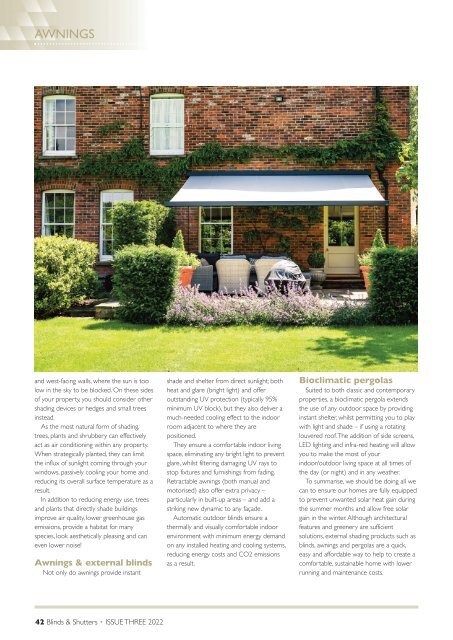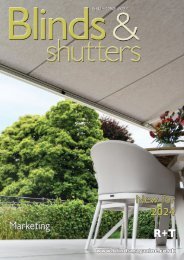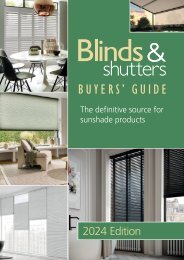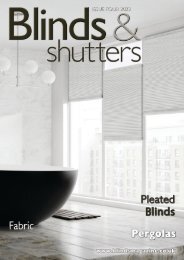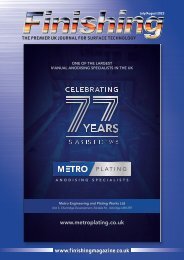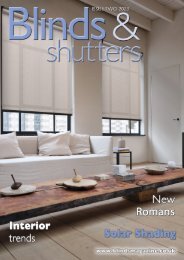Create successful ePaper yourself
Turn your PDF publications into a flip-book with our unique Google optimized e-Paper software.
AWNINGS<br />
and west-facing walls, where the sun is too<br />
low in the sky to be blocked. On these sides<br />
of your property, you should consider other<br />
shading devices or hedges and small trees<br />
instead.<br />
As the most natural form of shading,<br />
trees, plants and shrubbery can effectively<br />
act as air conditioning within any property.<br />
When strategically planted, they can limit<br />
the influx of sunlight coming through your<br />
windows, passively cooling your home and<br />
reducing its overall surface temperature as a<br />
result.<br />
In addition to reducing energy use, trees<br />
and plants that directly shade buildings<br />
improve air quality, lower greenhouse gas<br />
emissions, provide a habitat for many<br />
species, look aesthetically pleasing and can<br />
even lower noise!<br />
Awnings & external blinds<br />
Not only do awnings provide instant<br />
shade and shelter from direct sunlight; both<br />
heat and glare (bright light) and offer<br />
outstanding UV protection (typically 95%<br />
minimum UV block), but they also deliver a<br />
much-needed cooling effect to the indoor<br />
room adjacent to where they are<br />
positioned.<br />
They ensure a comfortable indoor living<br />
space, eliminating any bright light to prevent<br />
glare, whilst filtering damaging UV rays to<br />
stop fixtures and furnishings from fading.<br />
Retractable awnings (both manual and<br />
motorised) also offer extra privacy –<br />
particularly in built-up areas – and add a<br />
striking new dynamic to any façade.<br />
Automatic outdoor blinds ensure a<br />
thermally and visually comfortable indoor<br />
environment with minimum energy demand<br />
on any installed heating and cooling systems,<br />
reducing energy costs and CO2 emissions<br />
as a result.<br />
Bioclimatic pergolas<br />
Suited to both classic and contemporary<br />
properties, a bioclimatic pergola extends<br />
the use of any outdoor space by providing<br />
instant shelter, whilst permitting you to play<br />
with light and shade – if using a rotating<br />
louvered roof. The addition of side screens,<br />
LED lighting and infra-red heating will allow<br />
you to make the most of your<br />
indoor/outdoor living space at all times of<br />
the day (or night) and in any weather.<br />
To summarise, we should be doing all we<br />
can to ensure our homes are fully equipped<br />
to prevent unwanted solar heat gain during<br />
the summer months and allow free solar<br />
gain in the winter. Although architectural<br />
features and greenery are sufficient<br />
solutions, external shading products such as<br />
blinds, awnings and pergolas are a quick,<br />
easy and affordable way to help to create a<br />
comfortable, sustainable home with lower<br />
running and maintenance costs.<br />
42 <strong>Blinds</strong> & <strong>Shutters</strong> • ISSUE THREE <strong>2022</strong>


